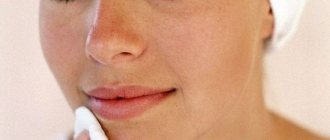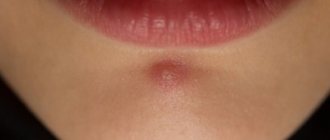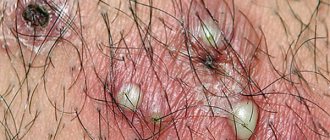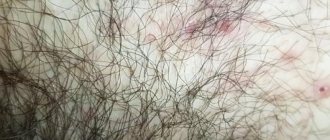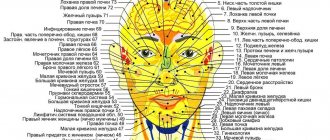Pimples are localized where they want. Often people face the problem of acne on the sternum. Acne in this area occurs in both men and women. This brings not only physical discomfort, but also affects the psychological mood. The issue of acne in the chest area is especially problematic for women. After all, women's blouses, shirts and dresses are more open, and there is no desire to hide luxurious forms under a layer of sweaters. It’s good when pimples are single and rarely appear on the chest. But what to do when small pimples on the chest are a constant occurrence? Perhaps this is a warning sign. Let's try to figure out this problem in our article.
Etiology of rashes on the chest
Rashes on the chest can be either single or multiple. Red and small acne that cover the entire chest often itch and itch, causing some discomfort. Sometimes red pimples, in the absence of necessary treatment, turn purulent.
Regardless of the cause that caused the problem, the inflammatory process on the skin in the décolleté area is usually associated with blockage of the sebaceous glands and the proliferation of pathogenic microorganisms on the protective surface.
Acne on the chest and back often appears at the same time, sometimes affecting other areas of the body, such as the neck, face and shoulders. It is in these areas that the largest number of sebaceous glands are located. In addition to red and purulent rashes in the chest area, you can also observe black dots, which are also a consequence of increased secretion of sebaceous secretions by the skin glands.
Who will help cure the problem
To identify the factors that provoked acne on the chest, you should consult a dermatologist. The doctor will prescribe the following examinations:
- clinical blood test;
- coprogram;
- general urine analysis;
- Ultrasound of the pelvic organs;
- blood test for hormones;
- tests for demodicosis and allergic dermatosis.
If immune, gastroenterological and gynecological problems are detected, you will need to consult doctors of other specializations - endocrinologist, immunologist, gastroenterologist, gynecologist, etc.
Influencing factors and reasons
The main provoking factors why acne appears on the chest are:
- hormonal disorders;
- increased sweating;
- long-term use of antibiotics;
- problems with the gastrointestinal tract;
- poor nutrition and abuse of bad habits;
- lack of nutrients in the body;
- allergic reactions to skincare products.
Acne on the chest in women in most cases occurs during the period of hormonal changes in the body, which are observed during pregnancy, menopause and during menstruation. Taking steroid hormones or stopping the use of contraceptives also often leads to red, inflamed elements, sometimes of a pustular nature, appearing on the chest and shoulders and nearby areas of the body.
In girls, acne on the face and chest is often a consequence of hormonal changes in the body, which is observed during puberty (transition).
Thyroid diseases can also cause rashes.
Increased sweating is one of the triggering factors for rashes under the breasts. Sweat is an ideal breeding ground for pathogens that cause inflammatory processes on the skin.
The causes of acne on the chest can also lie in long-term use of antibiotics. Medicines in this category lead to decreased immunity, disruption of the gastrointestinal tract and dysbacteriosis, which is one of the indirect causes of acne. All these factors inevitably lead to a decrease in the protective functions of the skin and the onset of the inflammatory process.
A gastrointestinal disease such as gastritis also often leads to the development of rashes on the body in adults.
Abuse of junk food, alcohol and smoking causes the accumulation of waste and toxins in the body, which inevitably lead to the development of an inflammatory process that often affects the skin. In addition, improper eating habits and bad habits contribute to the fact that the body does not receive the nutrients it needs, which also becomes a consequence of the development of acne.
Allergic reactions to skin care products, as well as synthetics, are another reason why acne appears on the chest. Irritation of the epidermis inevitably leads to a decrease in local protective functions and the development of an inflammatory process.
Insufficient or, on the contrary, excessive hygiene are secondary reasons for the development of acne in the chest area, which also contribute to a decrease in local immunity.
Types of rashes in the décolleté area
The rashes differ in shape, color, and size.
Depending on the type of pustular formations, the cause can be determined.
- Red , in the form of large spots, often accompanied by burning, itching, and painful sensations. Redness causes an inflammatory process characteristic of allergies and infectious pathologies.
- White non-inflammatory formations or closed comedones appear as a result of neglect of hygiene.
- Abscesses are formed with the active growth of pyogenic bacteria due to a weakening of the protective function of the dermis. This is facilitated by hormonal imbalance and pathologies of the endocrine system.
- Subcutaneous , as a rule, are localized near large blood vessels and lymph nodes. Rashes indicate a decrease in immunity.
When choosing a treatment method, pay attention not only to the type of formations, but also to additional symptoms.
How to get rid of acne on chest
First of all, they try to eliminate acne on the sternum in women using external agents based on azelaic acid, benzoyl peroxide, metronidazole, erythromycin, clindomycin, and isotretinoin.
In cases where local treatment is ineffective, they resort to taking oral medications. Depending on the cause of acne, retinoids, hormones, or antibiotics may be prescribed.
Weakened immunity is an indication for the prescription of immunomodulators and vitamins. In case of dysbacteriosis, which also contributes to a decrease in the body's protective functions, a course of probiotic therapy is carried out.
In some cases, when a rash on the chest in women causes psychological discomfort and leads to neuroses, sedatives are used.
Additionally, it is necessary to correct eating habits and provide proper care for the inflamed dermis.
External means
Chest acne can be treated with the following topical treatments:
- Skinoren;
- Baziron AS;
- Zenerite;
- Isotrexin;
- Metrogil;
- Chlorhexidine.
Skinoren is an anti-acne drug based on azelaic acid. The main active component acts in three directions at once: relieves inflammation, prevents the proliferation of microbes, and has a keratolytic effect. The rash on the chest is treated twice a day after the hygiene procedure. A significant improvement in skin condition is observed in the 4th week of regular use.
Baziron AS has a similar effect as the drug described above. The main active substance of the product is benzoyl peroxide, which has an anti-inflammatory and bactericidal effect, and also has the property of reducing the activity of the sebaceous glands. The gel can be applied up to two times a day. The full course of treatment is 6 weeks.
Zinerit includes two active ingredients - erythromycin and zinc. Thanks to these components, the inflammatory process in the skin and the proliferation of bacteria are stopped. Additionally, the product has a comedolytic effect.
Isotrexin contains an antibiotic (erythromycin) and a retinoid (isotretinoin). The drug suppresses the growth of pathogenic microflora, reduces sebium production, dissolves sebaceous plugs, exfoliates dead particles of the epidermis and relieves inflammation. The course of use of the product can vary from 6 to 8 weeks, depending on the severity of acne.
Metrogyl is a gel based on metronidazole, which has antimicrobial and anti-inflammatory effects. It prevents tissue damage due to its antioxidant properties, which is responsible for its anti-inflammatory properties. The gel demonstrates the greatest anti-acne effectiveness in combination with Differin.
Chlorhexidine and its analog Miramistin are often used to treat inflamed elements in cases where large areas have been covered. External use products show good antiseptic properties and drying effect.
Retinoids
One effective way to get rid of chest acne is to take retinoids. The most commonly prescribed are Roaccutane, Sotret and Acnecutane. Uncontrolled use of these medications can lead to serious consequences, so only a doctor can prescribe them.
Hormonal contraceptives
Acne on the neck and chest, which has a hormonal etiology, is often treated with the prescription of hormonal contraceptives that contain antiandrogens or estrogens. Medicines in this group include Yarina, Zhanin, Diane-35, etc. The duration of the course and dosage are established exclusively by the attending physician.
Antibiotics
The most commonly prescribed antibiotics are Dosicycline, Minocycline, Unidox Solutab and Amosicline. Systemic medications must be combined with local antibacterial agents. Drugs of this group, when taken for a long time, tend to accumulate in the skin and subsequently exhibit antimicrobial activity.
In case of acne due to gastritis, Amoxicillin is prescribed orally together with Metronidazole tablets. Both drugs interact with each other, showing activity against Hilobacter pylori.
Probiotic therapy
Acne on the sternum in women caused by dysbacteriosis is treated by taking probiotics ─ Rioflora, Bifiumbacterin, Linex, etc. The course of therapy is usually a month.
Vitamins
If there is a deficiency of vitamins A and E, an effective drug such as Aevit is prescribed. The vitamin complex is prescribed by a specialist, since its independent use can lead to adverse reactions, as is the case with retinoids.
Among other drugs, a special Merz tablet may be prescribed. In addition to retinol and tocopherol, the vitamin complex also contains other vitamins necessary for skin health (C, B vitamins, iron).
Immunomodulators
If the appearance of a rash is associated with immunodeficiency, then the attending physician will prescribe an immunomodulator. One of these is Wobenzym. The drug is a broad-spectrum immunomodulator and is considered mandatory for use during long-term antibiotic therapy, as well as in the event of dysbacteriosis.
Antihistamines
Taking antihistamines is indicated when allergic rashes appear. Many small pimples that itch are often the result of allergies, so they are eliminated with the help of Suprastin, Tavegil or some other antihistamine.
Clothes and acne
If acne appears only on the chest, then the reason may be in clothing. If you are wearing:
- tight, ill-fitting clothes;
- from synthetic materials;
- bras that create a greenhouse effect;
- if girls do not take off their bra while sleeping.
Such clothing can injure and rub the skin of the chest - and, as a result, irritation occurs on the skin, and then, possibly, acne. Treatment of chest acne in this case is very simple: wear comfortable, loose-fitting clothes made from natural fabrics, especially in summer. And lovely girls who constantly wear a bra day and night should know that this can cause acne on their bust.
Nutrition for rashes
Acne between the breasts, as well as in other areas of the chest, in some cases requires following a diet with the exclusion of junk food from the diet. It is recommended to first exclude from the menu those foods that contain simple carbohydrates. This category primarily includes sweets, baked goods, confectionery, chips, alcohol, etc.
Plant foods in the form of vegetables and fruits should predominate in the daily diet. Don’t forget about high-quality protein in the form of fish, meat, cottage cheese and eggs.
Fried, smoked, highly salted foods and semi-finished products should be completely avoided.
You need to drink at least 1.5 liters of water per day, not counting juices, compotes, fruit drinks and other drinks.
Possible complications
It would seem, what can be dangerous about acne that appears on the face and chest area? However, in some cases, these harmless neoplasms may indicate the onset of a pathological process, as well as the development of dangerous diseases such as Paget's disease and oncology. If at least one of the following signs appears, you should immediately seek medical help:
A rapid and very noticeable change in facial pigmentation, especially when you feel generally good.- Severe swelling of the face and throat, which is called Quincke's edema. Lack of medical care can lead to the death of the patient.
- Lack of oxygen, difficulty breathing. Changes in the color of skin rashes, especially if they have acquired an earthy tint.
- Dizziness to the point of loss of consciousness.
How to prevent acne
It is important to know not only how to remove acne on the chest, but also how to prevent its further occurrence. Prevention primarily lies in proper care. It is important to use gels for showering that do not disturb the natural pH of the skin and do not dry it out. You should take a shower or bath daily. In hot weather, it is recommended to wash with plain water without using cleansers up to twice a day.
If pimples appear under the breasts in hot weather, the affected area should be treated with Chlorhexidine and baby powder or talc should be applied to dry skin. In the case where there is a rash over the entire chest area, treatment with an antiseptic is also necessary to avoid deterioration of the condition of the skin.
It should be remembered that inflamed elements should never be pressed, even if one pimple pops up. Mechanical removal at home can lead to infection and spread of acne. It is permissible to cauterize a single inflamed element using iodine, salicylic alcohol and any other antiseptic.
Prevention
Acne is a chronic disease that cannot be cured completely. But if preventive measures are taken, the likelihood of relapse is reduced significantly. To prevent chest rashes, you need to:
- eat a balanced diet;
- avoid stressful situations;
- strengthen immunity;
- wear clothes made from natural materials;
- take a shower twice a day;
- treat cuts and abrasions with antiseptics.
Acne is a secondary disease that occurs when the endocrine, reproductive, digestive, immune and other systems are disrupted. Timely treatment of current diseases prevents purulent rashes on the body.
What can be done?
As already mentioned, if the problem is serious, you should consult a doctor. They will help to accurately determine the cause and prescribe adequate treatment. Or simply give advice appropriate to a specific situation.
But while waiting for a visit to the doctor, and also if for some reason you are unable to get to one, you can simply try to dry the chest area. Tar soap is perfect for this. It has a specific aroma, but don’t worry: the smell does not remain on the skin after washing. But the soap dries perfectly and does not cause allergies.
True, for delicate skin on the chest it is not advisable to use it too often. Otherwise, you will dry out the area, which will cause irritation. And this can have the opposite effect, that is, increase the number of acne, but for a different reason.
A mixture of lemon juice, water and tea tree oil cares for the skin and kills bacteria on the chest. True, if you have never used anything like this before, first check your body for allergies. That is, drop a little on your wrist and wait half an hour. If everything is in order, proceed.
So, to prepare the composition you will need 8 drops of essential oil for 3 tablespoons of juice and water. All this needs to be shaken and used for periodic wiping (no more than 3 times a day).
When should you sound the alarm?
It's normal to have pimples from time to time. If they are single, they can form due to a simple blockage of the skin. In this case, it is enough to wipe the skin with cosmetics produced specifically for such cases. But what to do if there are a lot of acne, they are painful, appear frequently and do not go away? Find out what the reason is and consult a doctor.
What specialists will help here? If you don't know what to do, make an appointment with a therapist, he will guide you further. But in general, skin rashes are treated by a dermatologist. In some cases, it is also worth visiting an endocrinologist: a purulent pimple often appears on the chest (especially in women) due to hormonal imbalance. You may also need other specialists during the diagnosis process.
